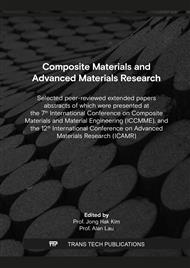[1]
Herrmann, Helmut & Bucksch, Herbert: Damping energy. 10.1007/978-3-642-41714-6_40173 (2014).
Google Scholar
[2]
X. Teng, N. Liu, J. Xudong: Vibrational Energy Flow Model for a High Damping Beam with Constant Axial Force. Mathematical Problems in Engineering, vol. 2020, p.11, (2020). https://doi.org/10.1155/2020/3584048.
DOI: 10.1155/2020/3584048
Google Scholar
[3]
B. Huang, J. Kuang, J. Tseng, J. Wang, Y. Qiu: Seismic Analysis of a Viscoelastic Damping Isolator. Advances in Materials Science and Engineering, vol. 2015, p.6, (2015). https://doi.org/10.1155/2015/280625.
DOI: 10.1155/2015/280625
Google Scholar
[4]
Z. Ying, Q. Chen, H. Bai, Y. Wu: Study on Damping Energy Dissipation Characteristics of Cylindrical Metal Rubber in Nonforming Direction. Advances in Materials Science and Engineering, vol. 2018, p.10, (2018). https://doi.org/10.1155/2018/5014789.
DOI: 10.1155/2018/5014789
Google Scholar
[5]
M. Parviz, K. Carla: Method of damped energy calculation for a multilayer viscoelastic (V.E.) damper. Journal of Wind Engineering and Industrial Aerodynamics Vol 36, pp.749-756, (2019). 10.1016/0167-6105(90)90072-K.
DOI: 10.1016/0167-6105(90)90072-k
Google Scholar
[6]
X. Lin, F. Li: Asymptotic Energy Estimates for Nonlinear Petrovsky Plate Model Subject to Viscoelastic Damping. Abstract and Applied Analysis, vol. 2012, p.25 (2012). https://doi.org/10.1155/2012/419717.
DOI: 10.1155/2012/419717
Google Scholar
[7]
T. Cheng, M. Ren, Z. Li, Y. Shen: Vibration and Damping Analysis of Composite Fiber Reinforced Wind Blade with Viscoelastic Damping Control. Advances in Materials Science and Engineering, vol. 2015, p.6, (2015). https://doi.org/10.1155/2015/146949.
DOI: 10.1155/2015/146949
Google Scholar
[8]
T. Cheng, Z. Li, Y. Shen: Vibration Analysis of Cylindrical Sandwich Aluminum Shell with Viscoelastic Damping Treatment. Advances in Materials Science and Engineering, vol. 2013, p.7, (2013). https://doi.org/10.1155/2013/130438.
DOI: 10.1155/2013/130438
Google Scholar
[9]
H. Wan, Y. Li, L. Zheng: Vibration and Damping Analysis of a Multilayered Composite Plate with a Viscoelastic Midlayer. Shock and Vibration, vol. 2016, p.10, (2016). https://doi.org/10.1155/2016/6354915.
DOI: 10.1155/2016/6354915
Google Scholar
[10]
P. Townsend, J.C. Suárez: Reduction of slamming damage in the hull of high-speed crafts manufactured from composite materials using viscoelastic layers, Ocean Engineering, Vol 159, pp.253-267, (2018). https://doi.org/10.1016/j.oceaneng.2018.04.029.
DOI: 10.1016/j.oceaneng.2018.04.029
Google Scholar



